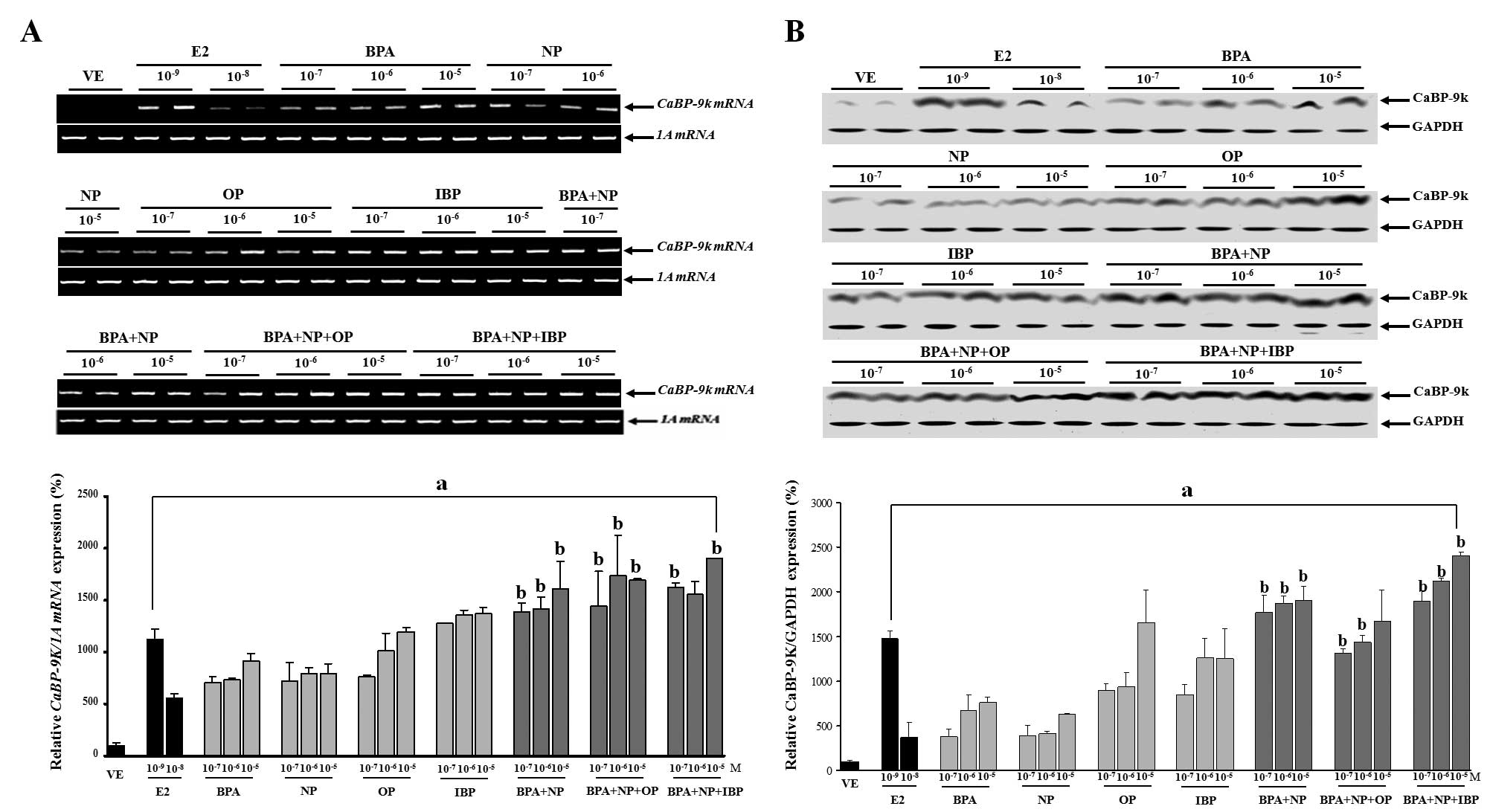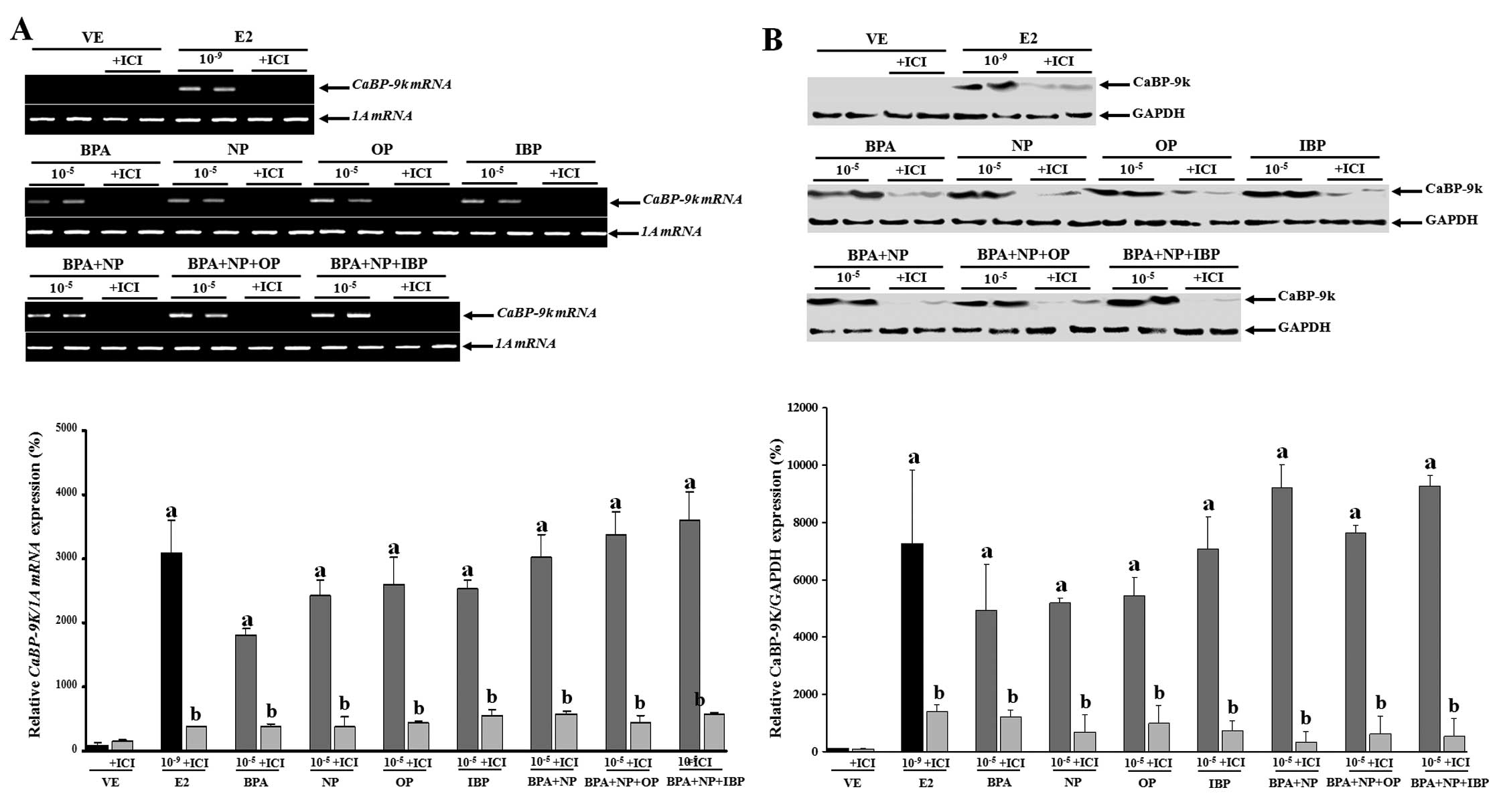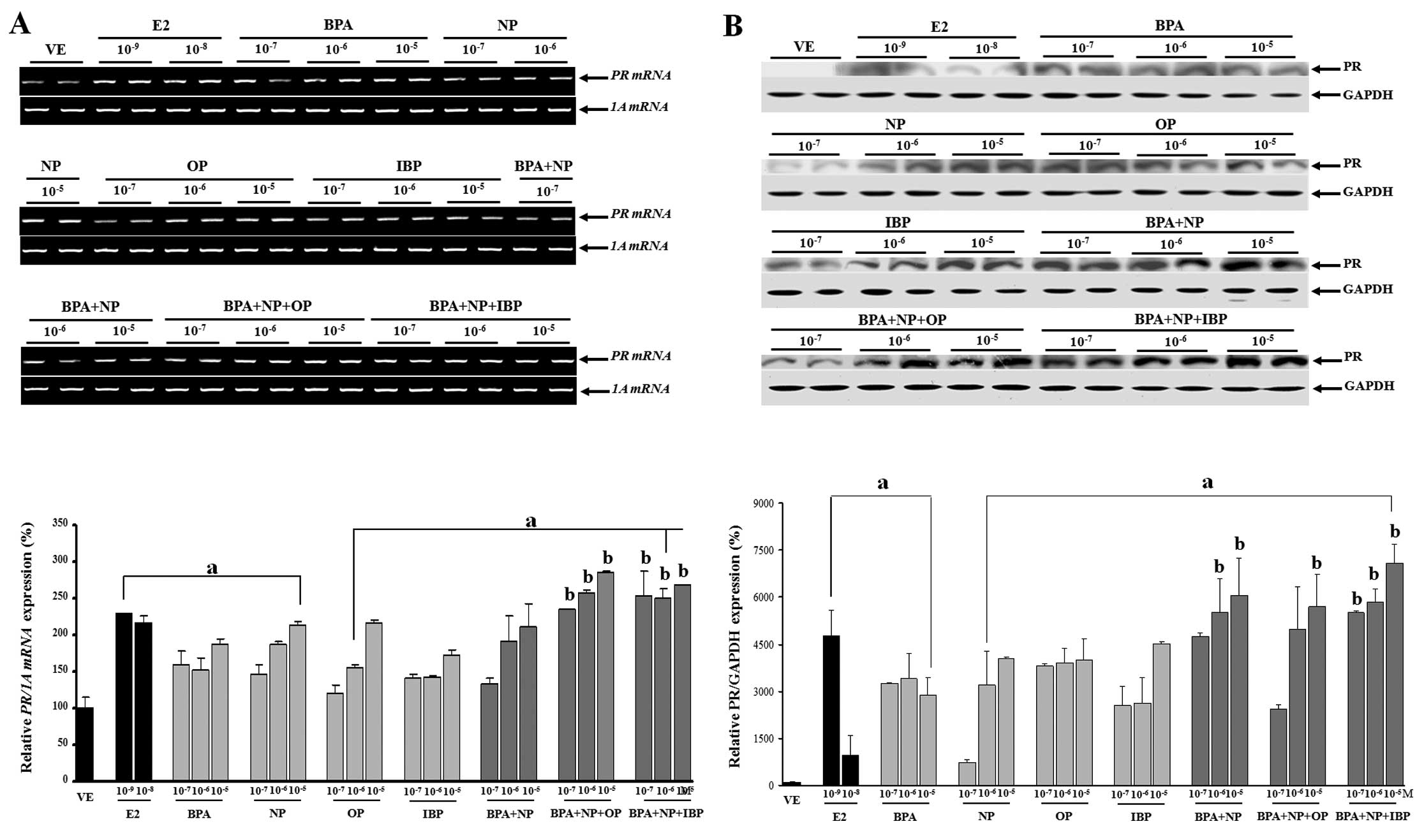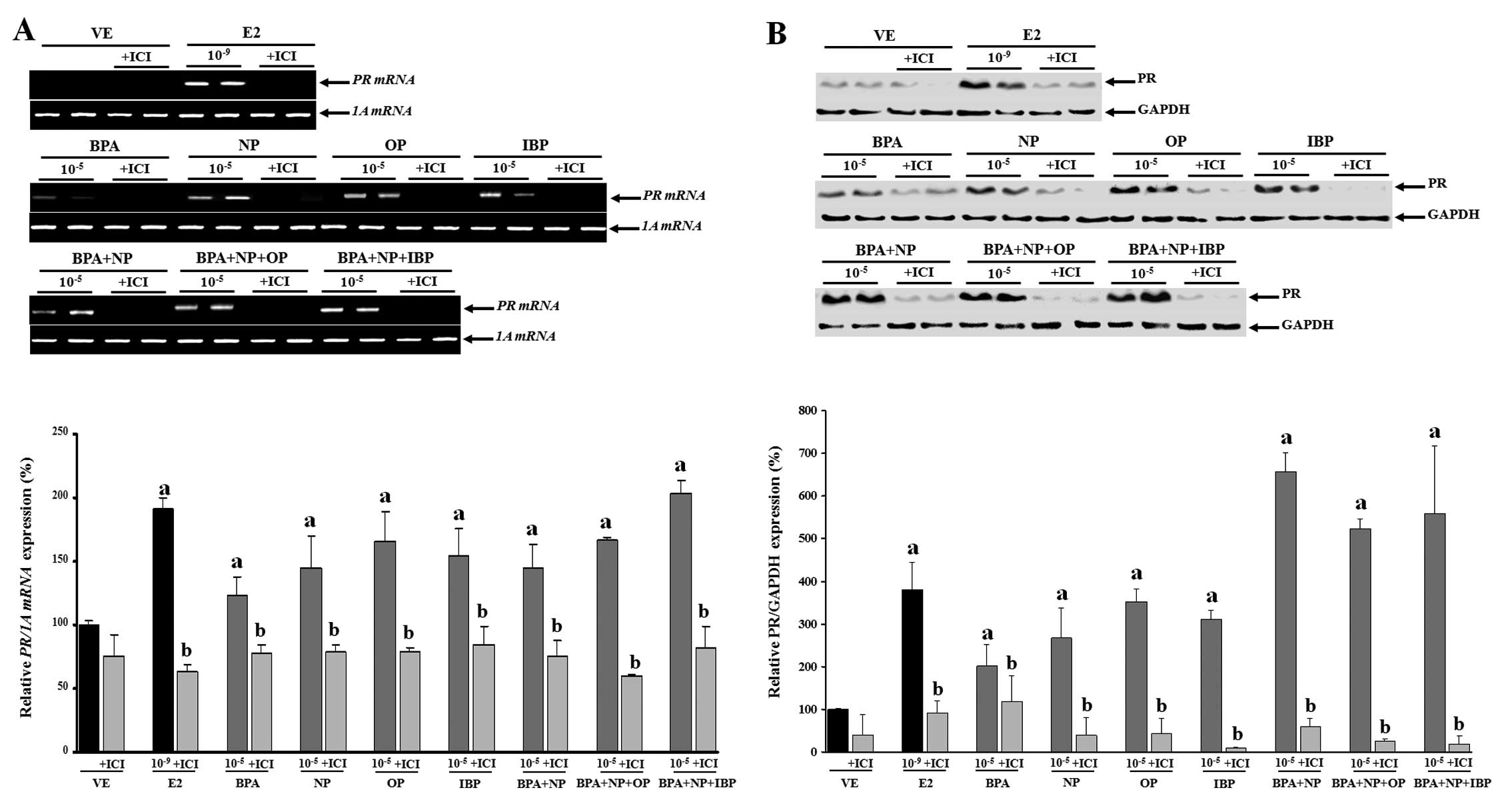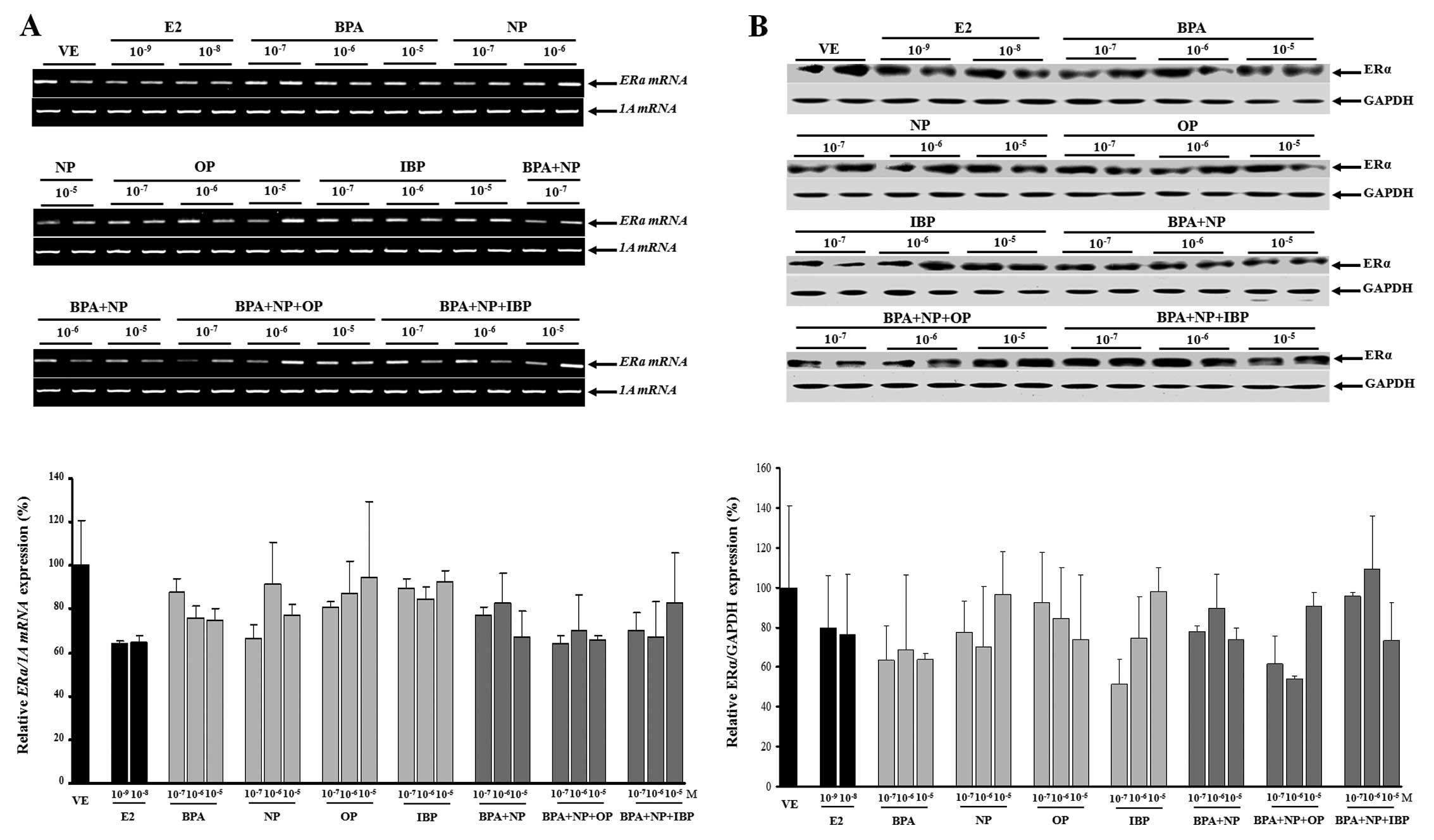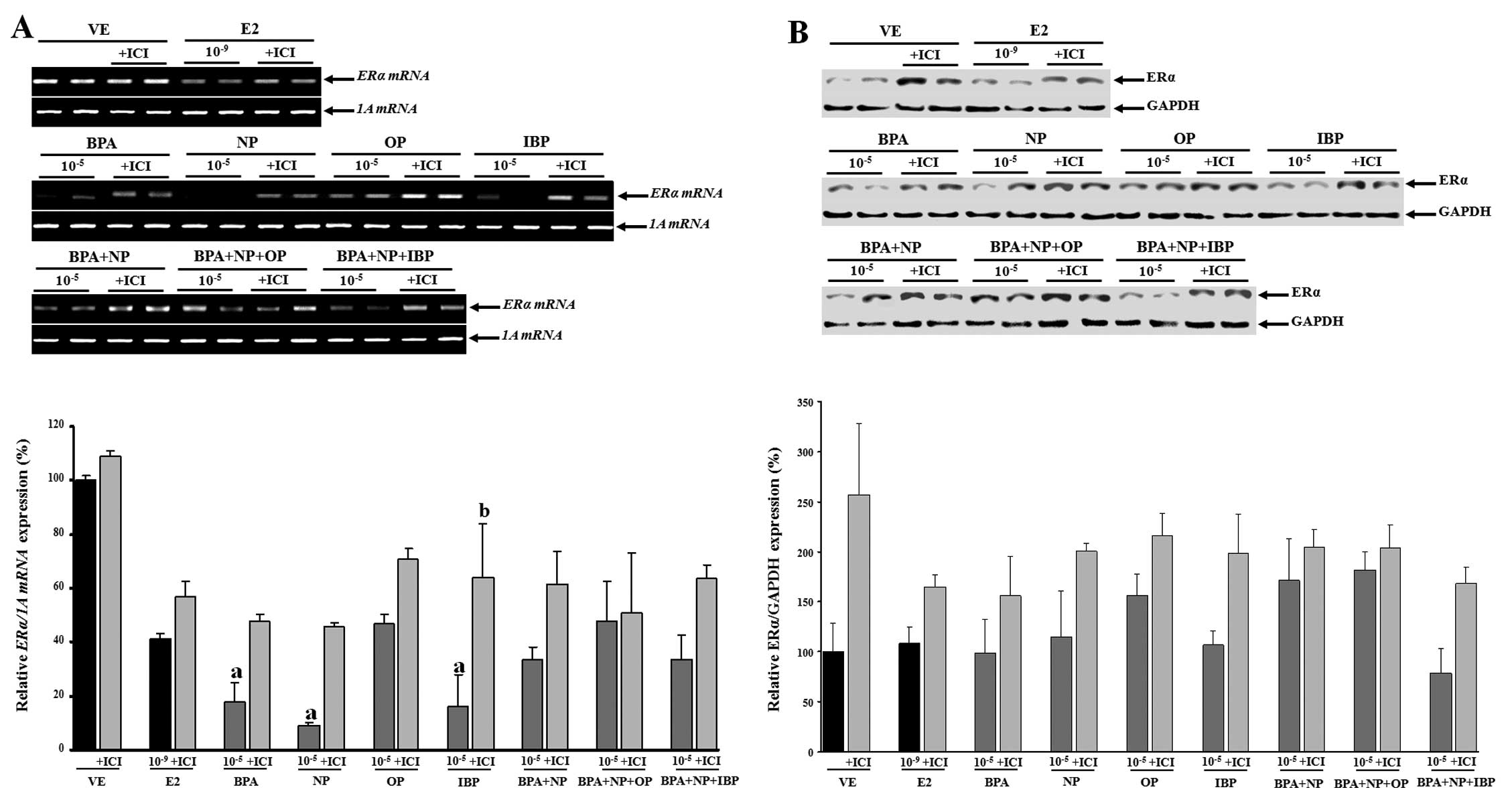Calbindin-D9k as a sensitive molecular biomarker for evaluating the synergistic impact of estrogenic chemicals on GH3 rat pituitary cells
- Authors:
- Published online on: September 6, 2012 https://doi.org/10.3892/ijmm.2012.1122
- Pages: 1233-1240
Abstract
Introduction
Evaluating the toxicity of combinations endocrine-disrupting chemicals (EDCs) is one of the most important toxicological issues. A previous study on the multiplicity of xenobiotics found in the environment have demonstrated the need to develop methods for evaluating the risk associated with different chemical combinations (1). The synergistic effects of EDCs have been previously reported (2); however, the mechanisms responsible for these interactions remain elusive. An assessment of the hazards associated with each of these chemicals alone has indicated that they have negligible risks (3). Nevertheless, the evaluation of each chemical individually does not clarify its effect when used in combination. Understanding the combined effects of EDCs may lead to an estimation of the hazards that exist under physiological conditions (4).
Many environmental chemicals classified as EDCs have been found to potentially disturb the endocrine system and organs that respond to endocrine signals (5). Among these EDCs, bisphenol A (BPA), 4-nonylphenol (NP), 4-tert octylphenol (OP) and isobutylparaben (IBP) are being produced and utilized at high levels, and are also found in high levels in the environment. Furthermore, only very limited data are available on the additive or synergistic estrogenic effects of these compounds. BPA is widely used for the manufacture of polycarbonate plastics and resins that are used as linings for food and beverage containers, and as dental sealants. Alkylphenolic compounds, including NP and OP, are components of soaps, paints, herbicides and pesticides, and are also used as additives in plastics (6). Parabens are widely utilized as preservatives in food, cosmetics and pharmaceutical products (7).
Although the estrogenic activity of EDCs alone is weak, the combined exposure to EDCs or industrial chemicals can induce additional burden to the body (8). Some of these compounds may have the ability to generate genomic instability rather than estrogenicity via non-classical pathways of the estrogen receptor (ER). For example, BPA, NP and OP alter cell cycle kinetics, induce DNA damage and produce telomeric associations (9). Previously, Roy et al (8) indicated that alkylphenols, including BPA are capable of producing mutations in the mitochondrial or nuclear genome by inhibiting DNA replication. When fish are exposed to alkylphenolic compounds, the expression of R-ras genes (R-ras1, R-ras2 and R-ras3) is induced (10). In addition, the upregulation of N-ras in the gonads, intestine and liver has been observed in hermaphrodite fish (K. marmoratus) following exposure to BP, NP and OP (11). Other studies have found that BPA and NP affect the central nervous system during embryonic development (12,13). Moreover, exposure to BPA and NP during the developmental stage results in a marked influence on neuronal vulnerability and synaptogenesis through mechanisms other than the ER-mediated pathway (14). Similar to many other xenoestrogens, parabens can mimic the effects of endogenous estrogen. Parabens have been shown to bind to ERs in the rodent uterus and induce estrogen-regulated gene expression in yeast cells (15). Furthermore, an association between the use of cosmetics containing parabens and an increased incidence of breast cancer in humans and animals has been reported (16,17).
The additive or synergistic burden of estrogenicity and genomic instability can produce more detrimental effects compared to estrogenic action alone. The estrogenic effect of the combination of 17β-estradiol (E2) and BPA has been shown to result in higher vitellogenin contents than treatment with a single treatment at identical concentrations in a time- and dose-dependent manner in male Chinese loaches (18). The synergistic effect of triiodothyronine plus BPA on growth hormone release is due to post-translational regulation, and BPA can disrupt thyroid hormone function in GH3 cells (19). In our previous studies, the synergistic effects of BPA and OP (20) or paraben (21) were evaluated. The results demonstrated that the combined exposure to these chemicals increases their synergistic estrogenic activities in vitro. In addition, the presence of combinations of industrial chemicals and parabens (e.g., Methyparaben and propylparaben in combination with phthalates) was observed in the majority of body care cosmetics (22). However, there are very few reports on the additive or synergistic effects of BPA, NP, OP and IBP in vitro or in vivo.
The gene that we used to measure the effects of EDCs in the present study, encoding the cytosolic calcium-binding protein, calbindin-D9k (CaBP-9k), has been extensively utilized for detecting estrogenic compounds in vitro and in vivo (23). CaBP-9k expression is rapidly and highly induced by estrogenic compounds (e.g., parabens, BPA, OP, NP, phthalates, methoxychlor, diethylstilbestrol and genistein) both in vivo and in vitro, possibly through an ER-mediated pathway (24–29). In the present study, we developed an assay for evaluating the synergistic impact of the exposure to combinations of EDCs on GH3 rat pituitary cells using the CaBP-9k gene as an estrogenic biomarker.
Materials and methods
Reagents and chemicals
E2, BPA and NP were obtained from Sigma-Aldrich (St. Louis, MO). OP was purchased from Fluka Chemie (Seoul, Korea). IBP was obtained from Tokyo Kasei Kogyo Co., Ltd. (Tokyo, Japan) and fulvestrant was purchased from Tocris (Ellisville, MO). A 1 M stock solution of each compound was prepared using 100% dimethyl sulfoxide (DMSO; Sigma-Aldrich, Ayrshire, UK) as a solvent and stored at −20°C to avoid contamination. All antibodies, including ones specific for CaBP-9k (P-18), ERα (MC-20), progesterone receptor (PR) (C-19), glyceraldehyde-3-phosphate dehydrogenase (GAPDH; A-3), goat anti-rabbit IgG (sc-362292), and goat anti-mouse IgG (sc-2005) were purchased from Santa Cruz Biotechnology, Inc. (Santa Cruz, CA).
Cell culture and treatment
GH3 cells were purchased from the Korean Cell Line Bank (Seoul, Korea) and maintained in Dulbecco’s modified Eagle’s medium (DMEM; Gibco-BRL, Grand Island, NY) with 10% fetal bovine serum (FBS; Gibco-BRL) plus penicillin/streptomycin (Gibco-BRL). The cells were incubated at 37°C in a humidified atmosphere containing 5% CO2 and were passaged every 7 days using 0.25% trypsin with 1 mM EDTA. In order to mitigate the effect of endogenous steroids, cells were cultured in phenol red-free medium containing 5% (v/v) charcoal dextran-stripped serum (DMEM-5% CD) for 7 days as previously described (30). The experimental treatments (DMSO as the negative control; 10−9 and 10−8 M E2 as the positive control; 10−7, 10−6 and 10−5 M of BPA, NP, OP and IBP alone or in various combinations with equivalent concentrations of each compound) were performed in triplicate. The cells were harvested at a single end-point (24 h after treatment) to measure mRNA and protein levels.
To examine the mechanism of CaBP-9k induction by these EDCs, the cells were pre-treated with 10−7 M fulvestrant for 30 min prior to EDC exposure as previously described (30). Following treatment with fulvestrant, the cells were exposed to a high dose (10−5 M) of BPA, NP, OP and IBP alone or combinations of these compounds (BPA + NP, BPA + NP + OP and BPA + NP + IBP).
Reverse transcription-polymerase chain reaction (RT-PCR) analysis
For RT-PCR analysis, GH3 cells were grown in 6-well plates (Nunc, Roskilde, Denmark), and stimulated with the chemicals (alone or in combination) 24 h later. The cells were harvested by trypsinization and washed twice in Dulbecco’s phosphate-buffered saline (DPBS; Gibco-BRL). Total RNA was isolated using TRI reagent (Ambion, Austin, TX) according to the manufacturer’s instructions. Complementary DNA (cDNA) was then generated with M-MLV reverse transcriptase (Invitrogen, Carlsbad, CA) and 9-mer random primers (Takara Bio, Inc., Shiga, Japan). cDNA (1 μl) was used for PCR at standard conditions: denaturation at 95°C for 30 sec, annealing at 55°C for 30 sec, and extension at 72°C for 1 min. The following primers were used: cytochrome c oxidase subunit 1 (1A) forward, 5′-CCA GGG TTT GGA ATT ATT TC-3′ and reverse, 5′-GAA GAT AAA CCC TAA GGC TC-3′; CaBP-9k forward, 5′-AAG AGC ATT TTT CAA AAA TA-3′ and reverse, 5′-GTC TCA GAA TTT GCT TTA TT-3′; PR forward, 5′-CAC AGG AGT TTG TCA AGG TC-3′ and reverse, 5′-GGG ATT GGA TGA ACG TAT TC-3′; and ERα forward, 5′-GAC TTG AAT CTC CAC GAT CA-3′ and reverse, 5′-CTT CAA GGT GCT GGA TAG AA-3′. The PCR products (8 μl) were separated on a 2% agarose gel and stained with ethidium bromide. The gel was photographed, scanned and analyzed using the Quantity One program (Gel Doc EQ; Bio-Rad, Hercules, CA). The housekeeping 1A gene was used for normalization. Data are shown as the average ± SEM of 3 independent experiments.
Western blot analysis
Following treatment with the EDCs, the cells were rinsed twice with DPBS solution. Protein samples were extracted with Pro-prep solution (Intron Biotechnology, Seoul, Korea) following the manufacturer’s instructions, and the total protein concentration of the supernatant was determined by a BCA protein assay (Pierce Chemical Co., Rockford, IL). Equal amounts of proteins were used for western blot analysis. Briefly, 30 μg of cytosolic protein were subjected to electrophoresis on 7.5 and 12% SDS-PAGE gels. The separated proteins were transferred onto nitrocellulose membranes (Millipore, Bedford, MA). The membranes were washed twice with PBS containing 0.05% Tween-20 (PBS-T) and then incubated in blocking buffer (5% non-fat milk; Difco, Franklin Lakes, NJ) for 2 h at room temperature. The membranes were then incubated with primary antibodies (anti-CaBP-9k, 1:500; anti-ERα, 1:500; anti-PR, 1:500; and anti-GAPDH, 1:2,000) overnight at 4°C. Incubation with secondary antibodies (diluted 1:3,000) was performed at room temperature for 1 h. Antibody-bound proteins were visualized with the ECL chemiluminescent system (Amersham Pharmacia Biotech, Arlington, VA) and exposed to CP-BU NEW X-ray film (Agfa HealthCare NV, Mortsel, Belgium). Band intensities were measured using a molecular analysis program (Gel Doc 1000, version 1.5; Bio-Rad) and normalized to GAPDH levels as previously described (30).
Statistical analyses
Data were calculated as a percentage of the vehicle control (DMSO) and expressed as the means ± standard error of the mean (SEM) of a single experiment performed in triplicate. Statistical significance was determined using one-way ANOVA followed by post hoc analysis (Tukey’s range test). P-values <0.05 were considered to indicate statistically significant differences.
Results
Combined effects of BPA, NP, OP and IBP on CaBP-9k mRNA and protein expression in GH3 cells
EDCs can interfere with hormone signaling through various mechanisms. Some of these mechanisms are interrelated in a manner that may result in synergistic interactions. In this study, we examined the hypothesis that combined exposure to chemicals which function as hormone receptor agonists may result in greater additive toxicity. We performed experiments by assessing the effects of the chemicals (BPA, NP, OP and IBP) alone or in combination on CaBP-9k mRNA and protein expression in GH3 cells. Exposure of the cells to BPA, NP, OP and IBP alone or in combination, at concentrations which were equivalent to those of each chemical alone, significantly increased both CaBP-9k mRNA and protein expression in a dose-dependent manner. In particular, doses of the combined chemicals from 10−7 to 10−5 M (BPA + NP), 10−7 and 10−6 M (BPA + NP + OP), or 10−7 and 10−5 M (BPA + NP + IBP), significantly increased CaBP-9k gene expression compared to identical doses of each chemical alone.
These findings implied that these EDCs had a synergistic impact on estrogenic activity in the cells. The results from the experiments in which the cells were exposed to the single or combined treatment of BPA, NP, OP and IBP are presented in Fig. 1.
Based on these findings, the cells were then treated with a high concentration (10−5 M) of the chemicals alone or in combination with or without fulvestrant (an anti-estrogen compound) to examine the mechanism underlying the synergistic effects of the examined chemicals (Fig. 2). The inhibition of CaBP-9k mRNA and protein expression following treatment with fulvestrant prior to treatment with the compounds (alone or in combination) was observed. These data suggest that the biological effects of BPA, NP, OP and IBP (alone or in combination) on CaBP-9k gene expression may involve an ER-mediated pathway in the GH3 cells.
Combined effects of BPA, NP, OP and IBP on PR mRNA and protein expression in GH3 cells
The effects of the single or combination treatment with EDCs (BPA, NP, OP and IBP) on PR mRNA and protein expression in the GH3 cells were evaluated. Four compounds elicited significant effects on both PR transcription and translation. Analysis of these results clearly showed that the EDC combinations at all doses, from 10−7 to 10−5 M of BPA + NP + OP or BPA + NP + IBP increased PR mRNA expression compared to each chemical alone. High doses of BPA + NP (10−6 and 10−5 M), BPA + NP + OP (10−5 M) and BPA + NP + IBP (10−7, 10−6 and 10−5 M) also increased PR protein levels (P<0.05) compared to the exposure to each chemical alone (Fig. 3). The discrepancy observed between PR transcriptional and translational regulation may be explained by mRNA stability and/or protein accumulation. On the contrary, pre-treatment with fulvestrant completely blocked PR mRNA and protein expression (Fig. 4). These results were concomitant with those observed for CaBP-9k, suggesting that the expression of CaBP-9k and PR genes was regulated in response to the combined effect of the estrogenic chemicals. In addition, the biological effects of the single or combined administration of BPA, NP, OP and IBP on CaBP-9k and PR expression may involve an ER-mediated pathway in GH3 cells.
Combined effects of BPA, NP, OP and IBP on ER mRNA and protein expression in GH3 cells
In this study, no evidence of a synergistic effect on ERα mRNA and protein expression was observed when the EDCs were combined (Fig. 5). The expression levels of the ERα gene were upregulated when the cells were treated with fulvestrant prior to being treated with single or combined doses of EDCs (Fig. 6); however, these changes were not statistically significant (except for treatment with 10−5 M IBP).
Discussion
There are a number of studies describing the potent estrogenic effects of BPA, NP, OP and IBP in vitro and in vivo (24,30,31). The relative levels of the estrogenic activity of these chemicals have been reported as E2>NP>OP>BPA (32). The ability of BPA to bind ERs is estimated to be 1/1,000 of E2 (33) and IBP showed an approximately 1,000-fold lower affinity than E2 (34). However, combinations of these EDCs at low concentrations used in consumer products have still shown estrogenic activities, and may be harmful to humans and animals (35). In a previous study, the combined effects of estrogens and xenoestrogens were shown to participate in non-genomic responses. The available experimental evidence showed that the effect of low-dose combinations may result in biological perturbation (36). Rajapakse et al (2) examined a combination of 11 xenoestrogens at levels close to their individual no observed effect concentrations (NOECs) and suggested doubling the dose of E2. Combinations of weak xenoestrogens (hydroxylated PCBs, benzophenones, parabenes, BPA and genistein) at low levels that individually have undetectable effects are able to create an impact on the actions of endogenous estrogens in body fluids and tissues (35). Furthermore, the combined estrogenic effects of EDCs are a risk factor for breast cancer in women (37).
Humans are exposed to a variety and combinations of natural and synthetic compounds that may influence various endocrine processes. From a hazard and risk assessment point of view, it is important to know whether exposure to combinations of these compounds results in additive, antagonistic, or synergistic actions (38). Very few studies have addressed the estrogenic effects of simultaneous exposure to 2 or 3 different EDCs. Our previous studies indicated that combined exposure to OP and IBP (20) or multiple parabens (21) at low concentrations synergistically affects the induction of CaBP-9k gene expression via an ER- or PR-dependent pathway. In the present study, we expanded the scope of our research to examine the synergistic effects of BPA, NP, OP and IBP on estrogenic activity in a rat pituitary cell line. The estrogenic effects of BPA + NP, BPA + NP + OP and BPA + NP + IBP combinations on CaBP-9k mRNA and protein expression were dose-dependent and more potent than those of the individual compounds administered at the equivalent concentrations. An endogenous gene expression assay that measures estrogen-induced alterations has been created and has been used extensively to detect the estrogenic activity of EDCs in vitro and in vivo (39). In previous studies, CaBP-9k was found to be expressed in a variety of mammalian tissues including the uterus, placenta, intestine, kidney, pituitary gland and bone (23,25,28,40). It has also been shown that CaBP-9k gene expression is highly modulated by E2 in rats, mice and dogs (24–26,30,31), suggesting that this gene may be used as a biomarker for evaluating the estrogenicity of putative estrogenic compounds (23). In the present study, our results showed that there was a synergistic effect when 2 or 3 estrogenic chemicals (BPA, NP, OP and IBP) were administered in combination. Based on our findings, we also suggest that the CaBP-9k gene is a suitable biomarker to assess the variation in the estrogenic activity of combined EDCs.
A previous study has demonstrated that a broad range of EDCs is capable of interacting with ERs and inducing ER-mediated responses (41). Cellular levels of estrogens regulate development and growth by inducing differentiation and cell proliferation classically through ERs by stimulating the transcription of target genes. The disruption of ER signaling pathways can contribute to adverse health effects, such as developmental reproduction abnormalities and endocrine-related cancers (42). To better understand the molecular events promoted by the administration of a combination of EDCs in this study, fulvestrant was used to examine the potential involvement of ER signaling in the individual or combined action of the compounds. The levels of CaBP-9k mRNA and protein were significantly increased in a synergistic manner, whereas pre-treatment with fulvestrant completely attenuated the single or combined effects on CaBP-9k gene expression. Of note, we found that the patterns of PR gene expression were similar to those of CaBP-9k in response to individual and combined chemical exposure. Pre-treatment with fulvestrant completely blocked PR expression. These results suggest that the single and combined effects of BPA, NP, OP and IBP require an ER-mediated signaling pathway. Although there were fluctuations in ERα mRNA and protein expression levels after treatment with these EDCs, no synergistic effect compared to the vehicle or each individual chemical was observed. In addition, the levels of ERα gene expression were not altered when the cells were pre-treated with fulvestrant.
In a previous study, treatment with industrial compounds (BPA, NP and OP) increased the expression of PR mRNA in the frontal cortex of adult ovariectomized rats (43). In CD-1 mouse uterus, exposure to 25 and 250 ng BPA/kg body weight/ day resulted in increased PR expression in the endometrium and subepithelial stroma (44). Okubo et al (45) found that MCF-7 cells treated with IBP exhibited a decrease in ERα gene expression while PR expression was enhanced. In addition, observing the involvement of ERs in paraben-induced responses has increased the understanding of the mechanism(s) underlying molecular events promoted by estrogenic compounds (25). Other studies have indicated that CaBP-9k expression is responsive to E2 via ER signaling in the rat uterus, ovary, and GH3 cells in which ERα, ERβ and PR are expressed (21,25,46).
In conclusion, the results of the present study provide evidence that combinations of BPA, NP, OP and IBP have synergistic effects on estrogenic activity in GH3 cells. In addition, this synergistic activity of the EDCs is induced via an ER-mediated signaling pathway. We also suggest that the CaBP-9k gene is an appropriate biomarker for evaluating the synergistic actions of EDCs in vitro. However, studies with wider concentration ranges and multiple combinations of EDCs in vivo and in vitro are warranted to determine the actual profile of xenoestrogenic activities.
Acknowledgements
This study was supported by a grant (12182KFDA638) from the Korea Food and Drug Administration. T.T.B.V. received funding from the Vietnam National Foundation for Science and Technology Development (NAFOSTED) no. 106.06-2011.33.



